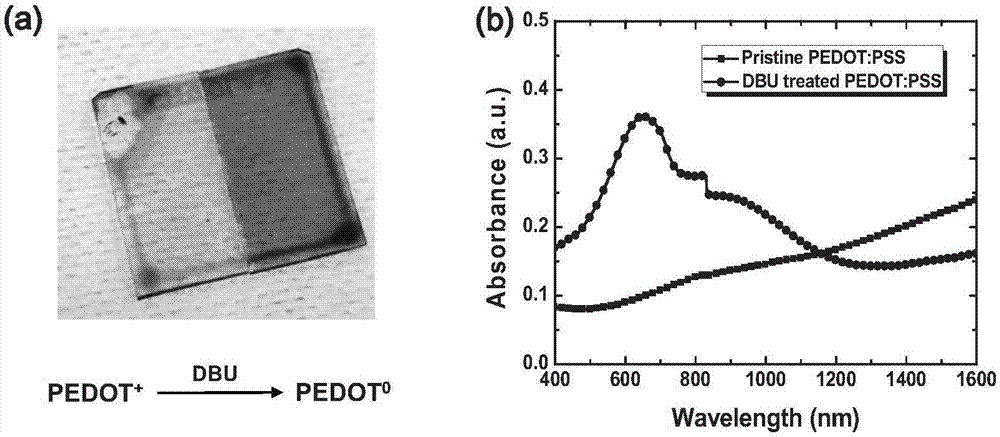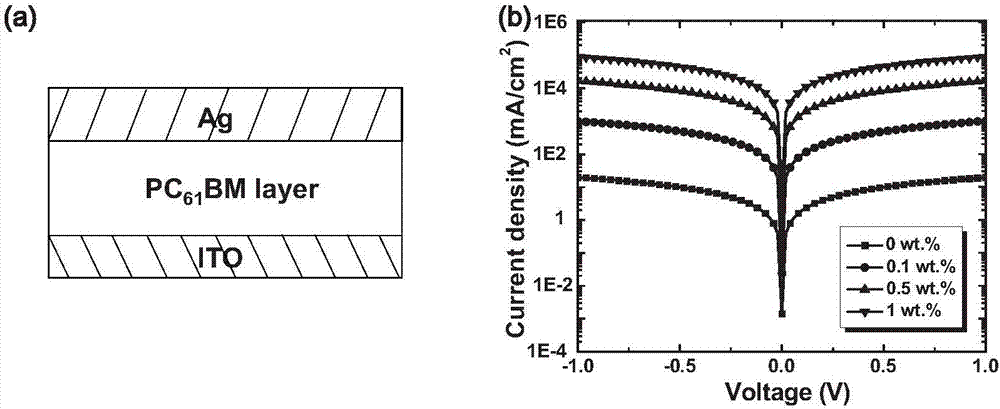Organic-amidine-molecule n-type dopant and application thereof in semiconductor photoelectric devices
A dopant and organic amidine technology, which is applied to the n-type dopant of organic amidine molecules and its application in semiconductor optoelectronic devices, can solve the problems of high development cost, difficult solution preparation, poor effect, etc., and achieve improved device The effect of high performance, simple doping process, and wide application prospects
- Summary
- Abstract
- Description
- Claims
- Application Information
AI Technical Summary
Problems solved by technology
Method used
Image
Examples
Embodiment 1
[0044] DBU to PC 61 BM, N2200 and ITIC for n-doping
[0045] According to different processes, use DBU to PC 61 BM, N2200 and ITIC are n-doped. First place the PC in a glove box filled with nitrogen 61 BM is dissolved in spectral pure chlorobenzene solvent, and the concentration of the resulting solution is 20 mg / ml. Then on the PC 61 Add DBU of different quality to the BM solution, heat and stir overnight at 50°C to achieve the 61 Doping of BM. The above-mentioned solutions with different doping concentrations were spin-coated into a film at a rotation speed of 1000 rpm, and the ultraviolet-visible absorption spectrum of the obtained film is as follows figure 1 (a). Preferably, the doping concentration for the electron transport layer of the perovskite battery device is 0.1 wt%. Take 50 microliters of the mixed solution with a doping concentration of 0.1 wt% and spin-coated on the surface of the prepared perovskite, which can be used as the battery electron transport layer. S...
Embodiment 2
[0047] DBU reduction conductive polymer PEDOT: PSS
[0048] PEDOT:PSS (PH1000) was spin-coated on a glass substrate at a rotation speed of 1000 rpm, and then placed on a hot stage at 140°C and annealed for 10 minutes to obtain a light blue PEDOT:PSS film, as follows figure 2 (a) Shown. Cut the glass sheet in half and place half of it in a watch glass with DBU, and place the watch glass on a hot table at 100°C for 5 minutes. Observe that the color of the PEDOT:PSS film gradually darkens To dark blue, indicating that PEDOT: PSS was restored by DBU. figure 2 (b) is the ultraviolet-visible absorption spectrum of PEDOT: PSS before and after being processed by DBU. It is obvious that the absorption of PEDOT: PSS in the visible spectral region becomes stronger after being reduced.
Embodiment 3
[0050] PC 61 Change of conductivity before and after BM doping
[0051] PC 61 The device structure of the conductivity test before and after BM doping is indium tin oxide glass / [6,6]-phenyl C 61 Methyl Butyrate / Silver (ITO / PC 61 BM layer / Ag). Among them, the bottom electrode is ITO conductive glass (indium tin oxide conductive glass), and the middle is PC before and after doping 61 BM layer, the top electrode is Ag, the structure is as image 3 (a). The specific preparation method of Example 3 is as follows:
[0052] (1) ITO glass is washed with soapy water, deionized water, acetone, isopropanol, and then ultrasonically cleaned by Plasma.
[0053] (2) In a glove box filled with nitrogen atmosphere, take the PC configured in Example 1 above 61 The BM solution was spin-coated on the cleaned ITO glass at a speed of 2000 rpm to obtain a 40nm thick pure PC 61 BM or doped PC 61 BM film. Then, a layer of 70nm Ag was evaporated by a vacuum coating apparatus.
[0054] (3) Test the current-vo...
PUM
 Login to View More
Login to View More Abstract
Description
Claims
Application Information
 Login to View More
Login to View More - R&D
- Intellectual Property
- Life Sciences
- Materials
- Tech Scout
- Unparalleled Data Quality
- Higher Quality Content
- 60% Fewer Hallucinations
Browse by: Latest US Patents, China's latest patents, Technical Efficacy Thesaurus, Application Domain, Technology Topic, Popular Technical Reports.
© 2025 PatSnap. All rights reserved.Legal|Privacy policy|Modern Slavery Act Transparency Statement|Sitemap|About US| Contact US: help@patsnap.com



